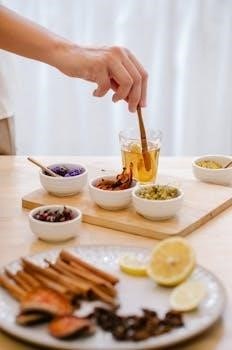Welcome to the world of Mei Leaf‚ where tea transcends a simple beverage and becomes an experience. This guide will navigate you through the art of brewing tea the Mei Leaf way‚ emphasizing flavor‚ technique‚ and a deep appreciation for the leaf. Prepare to unlock the secrets to exceptional tea.
Mei Leaf‚ established in London in 2006‚ represents a dedication to true tea culture‚ sourcing pinnacle teas from masters in the East. Forget tea bags; embrace the magic of the real leaf. Don and his team tirelessly explore mountains‚ seeking the most delicious teas on the planet. This journey is about more than just tea; it’s about understanding the craft‚ the terroir‚ and the traditions that shape each unique brew.
True tea culture‚ as Mei Leaf envisions it‚ involves appreciating the beautiful form and function of teaware‚ mastering the art of brewing‚ and recognizing the nuances of the leaf’s shape‚ texture‚ and color. It’s about moving beyond a blunt‚ quick experience and allowing the tea to shine in all its glory. This guide will introduce you to the philosophy and practices that elevate tea drinking into a mindful‚ sensory experience;
By exploring various brewing methods and understanding the importance of each step‚ you’ll learn to unlock the full potential of Mei Leaf’s exceptional teas. From white to puerh‚ discover the recommended temperatures and tea-to-water ratios for an optimal brew. Join us in celebrating the incredible leaf and becoming a tea connoisseur.
Understanding the Mei Leaf Brewing Philosophy
The Mei Leaf brewing philosophy centers around respecting the tea leaf and unlocking its full potential through mindful brewing practices. It’s not about rigid rules but about experimentation and understanding how different variables impact the final cup. Gong Fu brewing‚ in particular‚ embodies this philosophy by emphasizing control‚ craft‚ and the appreciation of every detail‚ from the teaware to the tea leaves themselves. This approach allows all aspects of tea to shine.
A key aspect is the leaf-to-water ratio‚ measured in grams per 100ml‚ which determines the tea’s strength and concentration. Another crucial element is water temperature‚ often overlooked but fundamental to your tea experience. Using the correct temperature extracts the desired flavors without scalding the leaves or creating bitterness. Rinsing the tea leaves before brewing softens them and prepares them for optimal extraction.
Ultimately‚ the Mei Leaf philosophy encourages you to explore and find your own perfect brewing style. By understanding the principles of Gong Fu brewing and experimenting with different techniques‚ you can elevate your tea drinking experience and fully appreciate the art and science behind each cup.
Essential Teaware for Mei Leaf Brewing
Selecting the right teaware is crucial for an authentic Mei Leaf brewing experience. While a classic cup is versatile for tasting sessions‚ the choice of brewing vessel significantly impacts the tea’s flavor and character. Porcelain and ceramic teaware are common choices‚ suitable for various teas‚ but may not retain heat as effectively as other materials‚ making them less ideal for teas requiring sustained high temperatures.
Clay teaware‚ especially unglazed options‚ are prized for their ability to enhance the taste and texture of tea. These pots are often rich in minerals that react with the tea‚ contributing unique nuances to the brew. Their high heat retention makes them particularly well-suited for big leaf oolongs and teas that require multiple infusions at high temperatures.
A gaiwan is also a versatile and essential piece of teaware for Gong Fu brewing. This lidded bowl allows for precise control over the brewing process‚ making it ideal for experimenting with different leaf-to-water ratios and infusion times. Ultimately‚ the best teaware is what resonates with you and enhances your enjoyment of the tea.
Water Quality and Temperature for Optimal Extraction
Water‚ comprising 99% of tea‚ plays a pivotal role in the final brew. The water you use is very important. Avoiding tap water is crucial; instead‚ opt for filtered water with a balanced mineral content. The pH level can also influence the tea’s taste‚ with a slightly higher pH often preferred.
Temperature is another critical factor‚ often overlooked but fundamental to your enjoyment. Different tea types require specific water temperatures to extract their optimal flavors. Green teas generally prefer lower temperatures to prevent bitterness‚ while black teas and oolongs benefit from higher temperatures to fully release their complex aromas and flavors.
Understanding the ideal temperature range for each tea type is essential for unlocking its full potential; Experimentation is encouraged‚ as slight adjustments can significantly impact the final cup. Observe how the tea responds to different temperatures and fine-tune your approach to discover your personal preferences. Remember the proper water temperatures often overlooked but its fundamental to your enjoyment of tea.
Leaf-to-Water Ratio⁚ Finding Your Perfect Balance
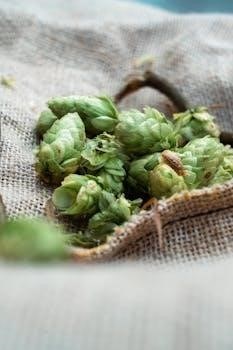
The leaf-to-water ratio is a crucial element in brewing exquisite tea. It dictates the strength‚ flavor intensity‚ and overall character of your infusion. Achieving the perfect balance is essential for maximizing the tea’s potential and crafting a cup that resonates with your palate. Don’t just throw some in and hope for the best.
Generally measured in grams of tea per 100ml of water‚ this ratio is not fixed but rather a guideline to be adapted based on tea type‚ personal preference‚ and brewing style. For instance‚ teas with larger leaves may require a slightly lower ratio‚ while tightly rolled teas might benefit from a slightly higher one.
Experimentation is key to finding your ideal ratio. Start with the recommended ratio for your specific tea and adjust accordingly. If the tea is too weak‚ increase the leaf quantity; if it’s too strong‚ decrease it. Remember‚ the goal is to achieve a harmonious balance where the tea’s flavors are pronounced without being overpowering. The journey to the perfect cup involves understanding and mastering the leaf-to-water ratio.
Rinsing the Tea Leaves⁚ Softening for Brewing
Rinsing tea leaves‚ often overlooked‚ is a vital step in the Mei Leaf brewing process. This practice‚ far from being merely ceremonial‚ serves a critical purpose⁚ softening the leaves and preparing them for optimal extraction during subsequent infusions. This initial rinse‚ typically lasting only a few seconds‚ awakens the leaves‚ allowing them to unfurl and release their flavors more readily. The aim is not to brew but to prepare.
The water temperature used for rinsing should ideally match that of your intended brewing temperature. This prevents thermal shock and ensures a gentle awakening of the leaves. Furthermore‚ rinsing helps remove any dust or unwanted particles that may have accumulated on the leaves during processing or storage.
By softening the leaves‚ rinsing allows for a more even and complete extraction of the tea’s compounds‚ resulting in a richer‚ more nuanced brew. It also helps to dissipate any initial bitterness‚ paving the way for a smoother‚ more enjoyable tea-drinking experience. Embrace the rinse as an essential prelude to unlocking the full potential of your Mei Leaf teas.
Gong Fu Brewing Method with Mei Leaf Teas
Gong Fu brewing‚ a cornerstone of the Mei Leaf tea experience‚ is more than just a method; it’s an art form that elevates tea preparation to a mindful practice. This approach emphasizes precision‚ control‚ and a deep connection with the tea itself. Key elements include using a gaiwan or small teapot‚ a high leaf-to-water ratio‚ and multiple short infusions.
The gaiwan‚ a traditional Chinese brewing vessel‚ allows for precise control over infusion times and pouring. Its open design enables you to observe the leaves as they unfurl‚ providing visual cues to the tea’s readiness. The high leaf-to-water ratio‚ typically measured in grams per 100ml‚ intensifies the flavor and aroma of each infusion.
Short infusions‚ ranging from a few seconds to a minute‚ allow you to extract different nuances from the leaves with each brew. This iterative process reveals the tea’s complexity and evolution‚ offering a dynamic and engaging tasting experience. Gong Fu brewing is not about following rigid rules; it’s about experimenting and discovering the unique potential of each Mei Leaf tea.
Cold Brewing Mei Leaf Teas⁚ A Different Approach
Cold brewing offers a refreshing alternative to traditional hot brewing methods‚ unlocking a unique flavor profile and creating a smoother‚ less bitter cup of tea. This method involves steeping tea leaves in cold or room-temperature water for an extended period‚ typically several hours or even overnight. The result is a tea that highlights the sweeter‚ more delicate notes of the leaves while minimizing the extraction of tannins‚ which contribute to bitterness.
Cold brewing is particularly well-suited for delicate teas like white and green teas‚ as it prevents the over-extraction that can occur with hot water. The slow‚ gentle extraction process coaxes out the tea’s natural sweetness and aroma‚ creating a harmonious and refreshing beverage. Furthermore‚ cold brewing is incredibly simple‚ requiring only tea leaves‚ water‚ and a container.
Experiment with different leaf-to-water ratios to find your preferred strength and flavor profile; Whether you’re seeking a light and refreshing summer drink or a smooth and nuanced tea experience‚ cold brewing offers a delightful way to explore the world of Mei Leaf teas. Embrace the simplicity and discover the unique flavors that cold brewing unlocks.
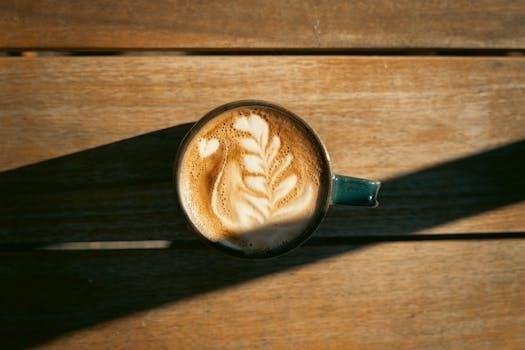
Brewing Instructions for Specific Mei Leaf Teas (e.g.‚ Jin Jun Mei)
Each Mei Leaf tea possesses a unique character‚ requiring specific brewing parameters to unlock its full potential. For instance‚ Jin Jun Mei‚ a premium black tea‚ benefits from a higher leaf-to-water ratio and shorter infusion times to showcase its distinctive qualities. A recommended starting point is around 5 grams of leaves per 100ml of water‚ with initial infusions lasting only a few seconds. This approach prevents bitterness and highlights the tea’s inherent sweetness and complex aroma.
White teas‚ on the other hand‚ often thrive with lower water temperatures and longer steeping times. This gentle extraction process coaxes out the delicate floral and fruity notes without overwhelming the palate. Similarly‚ green teas generally prefer cooler water to prevent bitterness. Experimentation is key‚ as personal preferences vary. Consult Mei Leaf’s online resources and videos for detailed guidance on brewing specific teas.
Remember to adjust the leaf-to-water ratio‚ water temperature‚ and steeping time based on your taste and the specific tea you are brewing. With a little practice‚ you’ll be able to consistently brew exceptional cups of Mei Leaf tea that showcase the unique characteristics of each leaf.
Experimental Brewing Styles⁚ Stacked and Arc Brewing
Venture beyond traditional brewing methods with Mei Leaf’s experimental techniques‚ such as stacked and arc brewing‚ which offer unique ways to interact with the leaves and extract nuanced flavors. Stacked brewing involves layering different teas in a single vessel‚ creating a complex and evolving flavor profile as the hot water interacts with each layer sequentially. This method requires careful consideration of the teas’ individual characteristics and how they might complement or contrast each other.
Arc brewing‚ on the other hand‚ focuses on the water’s trajectory and its interaction with the tea leaves. By pouring water in a specific arc‚ you can target certain sections of the leaves‚ influencing the extraction process and emphasizing particular flavor notes. Both stacked and arc brewing encourage experimentation and a deeper understanding of the brewing process. These styles are not about rigid rules‚ but rather about exploring the possibilities and discovering new dimensions of flavor.
These innovative methods challenge conventional brewing wisdom and invite you to engage with tea in a more tactile and intuitive way. Embrace the freedom to experiment and discover your own signature brewing style.
Common Tea Brewing Mistakes to Avoid
Even with the best tea leaves‚ certain common mistakes can hinder your brewing experience. One frequent error is using water that is not at the correct temperature. Overly hot water can scorch delicate tea leaves‚ resulting in a bitter and unpleasant brew‚ while water that is too cool may not fully extract the tea’s flavors. Another pitfall is using the wrong leaf-to-water ratio‚ either using too little tea and ending up with a weak brew or using too much‚ which can lead to an overly concentrated and bitter taste.
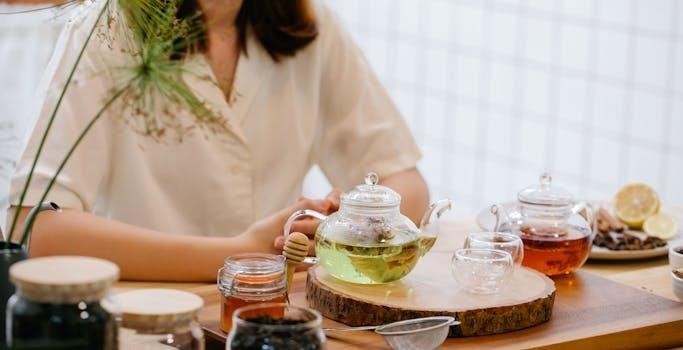
Failing to rinse the tea leaves‚ especially for compressed teas like Pu-erh‚ is another common mistake. Rinsing awakens the leaves and removes any dust or impurities. Over-steeping the tea is also a frequent issue‚ as it can release excessive tannins‚ leading to bitterness. Finally‚ neglecting water quality can significantly impact the taste of your tea. Avoid using tap water with chlorine or strong mineral content‚ and opt for filtered water instead. By avoiding these common mistakes‚ you can unlock the full potential of your Mei Leaf teas and consistently brew exceptional cups.
Tasting Tea Like a Pro⁚ Mei Leaf Techniques
Elevate your tea experience by learning to taste tea like a professional‚ using Mei Leaf techniques to discern the nuances and complexities within each brew. Begin by observing the color of the tea liquor‚ noting its clarity and hue‚ as this can provide clues about the tea’s oxidation level and processing. Next‚ inhale the aroma deeply‚ allowing the scent to fill your senses. Identify the various fragrance notes‚ such as floral‚ fruity‚ woody‚ or earthy‚ and consider how they evolve over time.
When tasting‚ take a small sip and let the tea coat your entire palate. Pay attention to the initial flavors‚ the mid-palate sensations‚ and the lingering aftertaste. Consider the tea’s body‚ texture‚ and mouthfeel‚ noting whether it is light‚ medium‚ or full-bodied‚ and whether it feels smooth‚ astringent‚ or creamy. Finally‚ contemplate the overall balance and harmony of the tea‚ considering how the various elements interact and contribute to the overall experience. By practicing these Mei Leaf techniques‚ you can develop a refined palate and unlock the full potential of your tea-tasting journey.
Resources⁚ Mei Leaf’s Online Guides and Videos
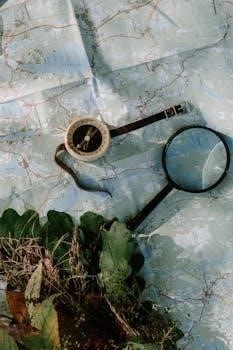
Dive deeper into the world of tea with Mei Leaf’s extensive collection of online resources‚ designed to guide and inspire tea enthusiasts of all levels. Explore their website for in-depth articles covering a wide range of topics‚ from tea origins and processing methods to brewing techniques and tasting tips. Discover the nuances of different tea types‚ including white‚ green‚ oolong‚ black‚ and pu-erh‚ and learn how to select the perfect tea for your palate.
Enhance your learning with Mei Leaf’s engaging video tutorials‚ featuring expert demonstrations and insightful commentary. Watch as Don and his team share their passion and knowledge‚ guiding you through various brewing methods‚ including Gong Fu Cha and cold brewing. Learn how to select the right teaware‚ control water temperature‚ and adjust leaf-to-water ratios to achieve optimal extraction. Whether you’re a beginner or an experienced tea drinker‚ Mei Leaf’s online resources offer a wealth of information to elevate your tea journey.
